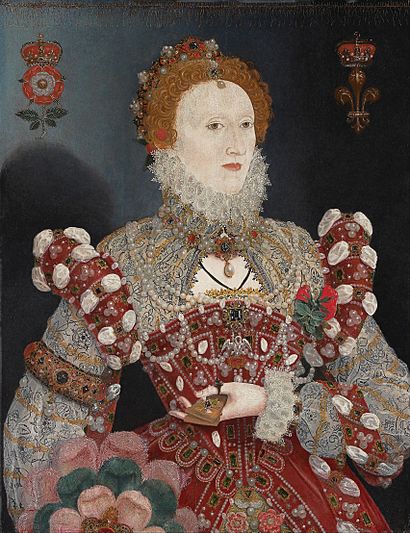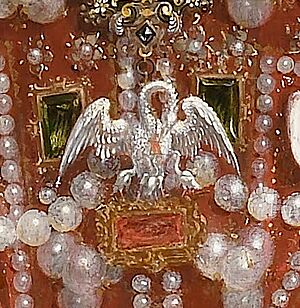Pelican Portrait facts for kids
Quick facts for kids Pelican Portrait |
|
|---|---|
 |
|
| Artist | Nicholas Hilliard |
| Year | 1575 |
| Medium | Oil on canvas |
| Subject | Elizabeth I of England |
| Location | Walker Art Gallery, Liverpool |
The Pelican Portrait is a famous oil painting of Elizabeth I of England. It was painted on a wooden panel around 1575. The painting gets its name from a special jewel Elizabeth wears. This jewel shows a pelican bird on her chest. Many people believe the artist Nicholas Hilliard painted this portrait. Experts have studied the painting and compared it to his other works.
For many years, the painting was kept at Charlton House in Wiltshire, England. It belonged to the Earls of Suffolk. In 1930, it was sold and later given to the Walker Art Gallery in Liverpool.
What's Special About It?
This painting was made when Queen Elizabeth was about 42 years old. The most interesting part is the pelican jewel she wears. It's called a "pelican in her piety." People at that time believed that a mother pelican would feed her babies with her own blood. The pelican in the jewel has its wings open and is pecking its chest.
This symbol was very important. It showed Queen Elizabeth as a caring mother to the English people. It meant she would sacrifice herself for her country. The Queen herself liked this pelican symbol a lot.
Queen Elizabeth's Look
In the portrait, Queen Elizabeth is dressed in very fancy clothes. She wears lots of beautiful jewelry. On her right arm, she has a decorated armlet. Her headdress and velvet dress are covered in jewels. There are many large pearls, which were a symbol of purity. Pearls also linked the Queen to Artemis, the Greek goddess of the Moon and purity.
You can see two cherries on her right ear. These might also suggest that she was the "Virgin Queen." Above her head, you can see a hint of a canopy. This suggests she is sitting in a throne room. The painting also includes a Tudor rose, which celebrates her family, the Tudors. A fleur-de-lis shows her claim to the throne of France. Her shirt and sleeves have special black designs. These designs show Tudor roses embroidered in black thread on white cloth.
Who Painted It?
It's not completely certain that Nicholas Hilliard (who lived from about 1547 to 1619) painted this. However, many experts are quite sure he did.
Hilliard painted Queen Elizabeth many times throughout her life. He started painting her in the early 1570s. He was almost her official court painter. He played a big part in creating her image as a strong and magnificent queen. Hilliard is best known for his tiny portraits called miniatures. But he also painted some larger portraits, like the Pelican Portrait.
This portrait has been compared to one of Hilliard's known miniatures of the Queen. Hilliard once wrote that the Queen liked to sit for him outdoors. She preferred to be painted in "the open alley of a goodly garden." She liked painting outside because there were fewer shadows.
Where Is It Now?
In 1801, the portrait was at Charlton House in Wiltshire. It belonged to the Earls of Suffolk. There was a story in the Howard family that Queen Elizabeth herself had given the painting to them. The painting was passed down through the Earls of Suffolk.
In 1930, Margaret Howard, Countess of Suffolk, sold it to a company called Spink & Son. They sold it to a collector named Alderman E. Peter Jones. In 1945, Mr. Jones gave the painting to the Walker Art Gallery in Liverpool.
See also


